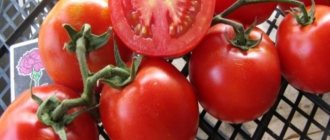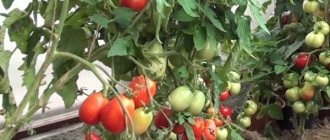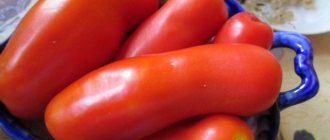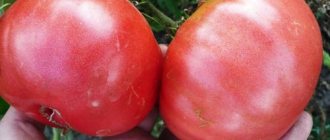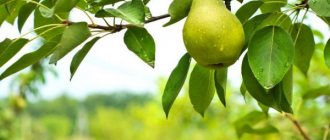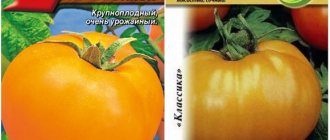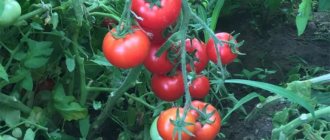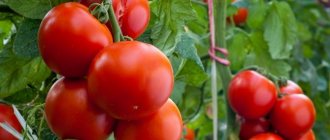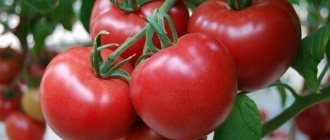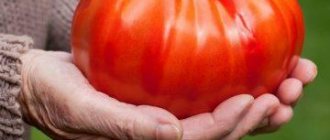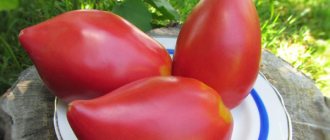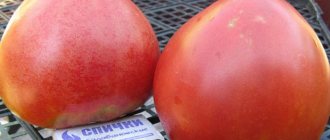Description of the variety
The Olya f1 variety was bred by Russian scientists at the beginning of the 21st century. It quickly gained popularity among vegetable growers. This variety is super-determinate, non-standard. The height of the plants reaches 100-120 cm.
Distinctive features
The Olya f1 tomato variety is grown in the winter-spring and spring-summer periods, as well as in extended rotation, that is, without transplanting into a greenhouse until November or December.
In the space between the leaves, in the internodes, three brushes are laid at once. The first of them are formed above the 7-9 leaves, each with seven fruits.
Reference. Fruit set occurs at night at 7°C or during the day at 13°C. No tomato has such an ability; many of the species stop pollination at this temperature and drop their flowers.
From the moment of emergence of seedlings to full ripening, 90-100 days pass, in extended rotation - 105 days.
The Olya f1 variety has increased resistance to tomato diseases such as cladosporiosis, fusarium and tobacco mosaic. It is shade-tolerant and heat-resistant. The tomato is recommended for growing in greenhouse conditions and open ground. The hybrid can be grown in a greenhouse all year round.
Fruit characteristics and yield
The harvest is rich: from 1 sq. m you can collect up to 15 kg of fruit, in an extended rotation - up to 25 kg.
Due to the small number of shoots, pinching is not required, but you can’t do without a garter.
The fruits are medium-sized, their weight can reach up to 170 g. They have a round shape and a bright red color (see photo above), with a sweet and sour taste. These tomatoes have 4-6 seed chambers.
The purpose of the tomato is universal: it is suitable for fresh consumption, pickling, marinades, canning, preparing sauces, ketchup and other dishes.
Diseases and pests
This tomato has a fairly high immunity, so the Olya hybrid does not suffer from diseases that become destructive to other tomatoes:
- from tobacco mosaic virus;
- from verticillium;
- from fusarium wilt;
- from neck rot;
- from brown spot;
- from late blight of fruits and stems.
Description of tomato diseases - video
But still, too long a period of bad weather can cause the development of cladosporiosis in this tomato.
Of the “harmful” bugs, Olya’s tomato has the highest resistance to nematodes.
Tomato diseases:
Why tomato leaves dry out and turn yellow. Tomato blossom end rot in a greenhouse.
How to grow seedlings
Summer residents are preparing for the season already in February-March. High-quality seeds and seedlings are the key to a good harvest.
Seed preparation
To prevent disease, seeds are disinfected with potassium permanganate or hydrogen peroxide. A proven method is to soak the seeds for 20 minutes in a 1% solution of potassium permanganate.
Then they need to be saturated with nutrients. To do this, use solutions of potassium or sodium humate, aloe vera juice or potato water. There are also special preparations, for example, “Immunocytophyte”.
All that remains is to harden the seeds. Tomatoes love warmth, and this procedure will help them withstand unexpected temperature changes. Seeds that have sprouted first are left in the refrigerator overnight and then returned to the heat for the day. This needs to be done 2-3 times.
Sowing
It begins 45-55 days before planting seedlings in the ground. Seeds are sown in small containers, common or individual. The soil is prepared from one part peat, one part sawdust and two parts greenhouse soil. The sawdust is first disinfected with boiling water, then steamed with a hot urea solution.
To one bucket of prepared soil add two handfuls of crushed shells, 0.5 liters of ash, 2 tbsp. l. superphosphate. Then mix thoroughly and pour in a hot solution of light-colored manganese. When the earth has cooled, fill the planting containers halfway.
After planting the seeds, the containers are covered with film or glass and left indoors at a temperature of 22-24°C.
When shoots appear, the film is removed and the containers are moved to a more illuminated place. Since the tomato is shade-tolerant, it is not necessary to place the seedlings in a sunny place.
The first watering is 2 tsp. carried out on the fourth day, distributing water along the edge of the nursery. After the formation of the third leaf, 100 ml of water is allocated to each bush.
When two true leaves appear, the seedlings are picked and placed in separate containers. To slow down the overgrowth of seedlings, they are planted again after 21 days.
Reference. Picking promotes the development of lateral roots, which leads to strengthening of seedlings.
At the age of seven days, the sprouts are sprayed with Epin to increase immunity. The first fertilizing is carried out 10 days after the first picking with Fertika Lux or Clean Sheet fertilizer.
Two weeks before transplanting, the seedlings begin to harden. To do this, they are taken outside for 2-3 hours, and the night temperature in the room where the seedlings are located is reduced to 14°C. Gradually, the time the sprouts stay outside increases to 18 hours.
Planting seedlings in a permanent place
Transplantation into closed ground is carried out in mid-May, into open ground - at the beginning of June. By the time of planting, the seedlings should have 7 full leaves. Transplantation is carried out only in the morning or evening, when direct sunlight does not fall on the garden bed. A week before the procedure, the area under the beds should be sprinkled with ash (300 g per 1 sq. m). You can add rotted sawdust (3–4 kg per 1 sq. m).
Find out why the leaves on tomatoes turn yellow.
In the evening before planting, the soil is loosened to a depth of 10 cm. 2 hours before replanting, holes are formed with a depth of 30 cm. The distance between plants is kept at 30 cm, between rows - 50 cm. 2 liters of water are poured into each planting hole, adding 3-5 manganese crystals. The bottom layer of foliage is removed from the seedlings.
When the liquid is absorbed, fill a third of the hole with soil, then carefully remove the plants from the pots, trying not to damage the roots, since by the time of replanting they already occupy the entire area of the container. When filling the holes with soil, it is compacted to prevent air holes from appearing and to speed up the establishment of the plant. Seedlings growing in peat pots are immediately placed in the holes along with the pots.
Important! When planting in a permanent place, super-determinate varieties are best buried in the soil up to half the height of the stem. This makes it possible to form a bush with 2 stems and ensure that the root system is firmly anchored in the soil.
After completing all the work, water the hole with the plant with 1 liter of water. A support is driven in nearby and the plants are tied up.
How to grow tomatoes
After 45-55 days, the seedlings are ready for transplanting into open ground.
Planting pattern: 50 cm – distance between bushes, 40 cm – between rows. For 1 sq. m place no more than six seedlings, otherwise fruiting will decrease.
After planting in shallow holes, the soil is loosened, hilled up and moderately watered with warm, settled water. Watering is done at the root of the plant. Further watering is carried out as the soil dries, but not more than 1-2 times a week. To retain moisture longer, the soil is mulched.
Reference. Loosening the soil promotes better oxygen supply to the roots.
During the growing season, the plant is fed with mineral complexes in the form of phosphorus and potassium fertilizers once every 14 days.
It is undesirable to feed with nitrogen fertilizers due to the formation of a large amount of greenery, while there will not be enough nutrients for fruit set.
Due to the small number of shoots, the crop does not need pinching. But if the stepson appears before the first fruiting cluster, it is removed. This is the lowest shoot, which does not participate in the development of the seedling and can cause late blight.
Seedlings must be tied to wooden or metal rods. As the stem grows, it is carefully fixed to the support. Fixing branches is also possible.
Fertilizing vegetables
If you do not apply fertilizer to the Olya tomato bushes after transplanting the seedlings, the ripening fruits will be much smaller than the stated size in the description of the variety.
The first time tomato bushes are fed a couple of weeks after transplanting the seedlings to a permanent place. In this case, a yeast solution is added to the soil, which will saturate the tomatoes with nitrogen.
After a couple of weeks, you can feed these vegetable plants with a solution of ash infused for 24 hours.
After 12-14 days, a solution of iodine and boric acid is added to the soil.
Tomato feeding
Also, after each watering, the ground around the bushes is mulched with any organic substances, and the bushes are fed “leaf by leaf” with ammonia and hydrogen peroxide.
Features of cultivation and possible difficulties
Tomato Olya f1 reaches a high growth, and several brushes appear on the central shoot at once. Therefore, experienced gardeners grow this variety in two shoots, when the second one starts from under the first brush. Remove all flowers and tops - this will help Ole not waste nutrients on unnecessary tops. Immediately sprinkle the cut area with charcoal or activated carbon.
It is important to remove side shoots in time: when the stepsons have reached a height of 3-4 cm. Pluck them at the very base in the first half of the day and in dry weather. If you leave the tip, it will begin to rot and poison the entire bush.
Don't overfeed tomatoes! If you give them too much manure, the bush will become overgrown and the fruit will be small and green.
Diseases and pests
The hybrid is considered a highly resistant crop to the main diseases of the nightshade family. However, sometimes it is powerless against late blight and brown spot.
Late blight can be prevented by loosening the soil, removing weeds and moderate watering. The main thing is to monitor the humidity level.
Late blight is a fungal disease that loves plenty of moisture and elevated ambient temperatures. Copper sulfate is also suitable as a prophylactic agent.
When treating late blight, the fungicide “Hom”, treatment with furatsilin or soda (1 tbsp per 0.5 bucket of water) will help.
Brown spot is also a fungal disease, so preventive measures will be similar. As for treatment, copper-containing fungicides, for example, “Barrier” (8 g per 10 liters of water), will help here.
Among the pests, the mole cricket and the Colorado potato beetle are dangerous. The mole cricket is repelled by strong odors, for example, a crushed head of garlic, which is buried in the ground. And the Colorado potato beetle, along with its larvae, is collected by hand and burned in glass jars.
Agricultural technology of tomatoes Olya F1
Tomatoes of the Olya variety are grown in seedlings or by direct sowing in the ground in the southern regions. When there is a threat of frost, temporary shelters are created for them.
Picking is carried out in the phase of 2 true leaves. Further care consists of timely watering and fertilizing with nitrogen fertilizers.
Tomato seedlings are planted in a permanent place according to a 50 cm by 40 cm pattern. Ash, humus (1 handful), superphosphate and potassium sulfate (1 tsp) should be poured into each hole. After planting, water the tomatoes. Further care consists of timely feeding, weeding, watering, and loosening. Stepchildren are removed only up to the first brush. After this, the tomato is formed according to the rules. If necessary, it should be tied to a support. Once the crop is ripe, the plants can be removed.
Growing seedlings
To get Olya tomato seedlings, you need to sow at the end of March. In two months it will be ready for planting in the ground.
Before sowing, seeds are subjected to several procedures:
- sorting or culling - immersion in a solution of table salt (1 teaspoon per glass of water) and selection of seeds that have settled to the bottom;
- etching - disinfection in a weak solution of potassium permanganate;
- soaking in a growth stimulator - carried out to increase germination;
- hardening - placing in the refrigerator for several hours;
- bubbling – saturating seeds with oxygen using an aquarium compressor.
For sowing, you need to prepare the soil and containers. A mixture consisting of:
- from peat – 1 part;
- sawdust - 1 part;
- greenhouse soil - 2 parts.
All components must be thoroughly mixed and disinfected by calcination, treatment with potassium permanganate or freezing. Moist soil is poured into disinfected containers and the seeds are placed at a shallow depth. Having covered the crops on top with film, the containers are transferred to a warm place. After the seedlings emerge, tomato seedlings of the Olya variety are placed in a cooler place, and additional lighting is installed for the seedlings. In the phase of three true leaves, a pick should be carried out, and after three weeks, repeat it again. At ten days of age, seedlings are sprayed with a solution of a growth stimulator to increase the immunity of seedlings. Watering is carried out regularly, carefully, as the soil dries.
Landing rules
Tomato seedlings of the Olya variety are transplanted to a permanent place in the phase of 5 - 7 true leaves in a greenhouse - in mid-May, in early June - in open ground. Plants are distributed according to a 50 cm by 40 cm pattern in prepared holes. The soil is mulched. If there is no mulch, the soil must be loosened after each watering. Young plants are moistened regularly and moderately, while adults are moistened abundantly and rarely. Tomato variety Olya is fertilized three times during the entire growing season, using fertilizers according to the instructions. There is no need to pin the bush, but the plant needs to be staked regularly so that it does not break under the weight of ripening fruits.
Watering and fertilizing
Getting a good harvest directly depends on watering the plants. In this case, the following rules must be observed:
- soil moisture should be 85%, air humidity - 50%;
- watering is carried out 2 times a week, adjusted for climatic conditions;
- for tomato bushes of the Olya variety, 2 liters of water is enough for young plants and 5 - 6 liters for adults;
- if the leaves of the plants droop, it is necessary to carry out urgent, abundant watering;
- the best time for this procedure is early morning;
- drops should not fall on the leaves;
- water should be used warm and settled;
- The ideal option for moisturizing is drip irrigation.
You should carefully monitor the behavior of tomatoes of the Olya variety. With a lack of moisture, the foliage curls and the ovaries crumble. If the soil is waterlogged, the fruits turn black, burst, and the tomato gets sick.
The basic principle of watering is the expediency and timeliness of the procedure.
Tomatoes of the Olya variety are fed 3-4 times per season:
- thanks to nitrogen fertilizers, green mass increases, but fruit ripening is inhibited;
- phosphorus-potassium fertilizers are used during fruit set;
- potassium influences ripening;
- microfertilizers containing boron and magnesium are important for the ovaries during flowering.
Organic fertilizers used for Olya tomatoes in the form of liquid fertilizers and soil mulching have a good effect.
Pinching and tying
The advantages of Olya variety tomatoes include the almost complete absence of the need for pinching the bush. The whole process comes down to removing the stepsons that appeared before the first brush. The places where they are broken out or cut out must be treated with crushed coal or wood ash.
Each tomato bush must be tied to a strong support as it grows. The trellis or support must be reliable, since the number of trusses of the Olya tomato variety that ripen at the same time is large, and their weight is significant. If the strength is insufficient, the plant will “lie” on the ground, which can lead to the death of both itself and the ripening crop.
Formation
The tomato variety Olya is a determinant tomato; its development stops at a certain stage: when the flower clusters form, the top stops growing. Further development of the bush continues from the stepsons growing from the axils of the leaves. To prevent the plant from stopping its growth, it is important not to remove them.
Protection from diseases and pests
Tomato variety Olya F1 is resistant to most diseases, but if growing rules are violated or unfavorable weather conditions, it can be susceptible to late blight, rot, and brown spot. For the purpose of prevention, the plant should be treated with drugs that strengthen the immune system and suppress the development of diseases (“Barrier”, “Barrier”). A solution of copper sulfate will help destroy brown spot and rot.
Like other tomatoes, the Olya tomato variety can be affected by mole crickets and whiteflies. The preparations “Grom” and “Phosbecid” are effective pest repellents.
The nuances of growing in open ground and greenhouses
The variety is recommended for cultivation in open ground and greenhouse conditions. The climate of the North Caucasus region is suitable for open ground. Tomatoes are grown in protected ground all year round, regardless of climatic conditions.
In the greenhouse, the height of the seedlings reaches 1.2 m. This is slightly higher than in open beds. At this height, up to 15 clusters are formed on the trunk. The fruits ripen simultaneously on three branches, differing little in size from each other.
In both protected and unprotected soil, all lower leaves are removed, otherwise, with constant contact with moisture, the leaves may rot.
It is necessary to avoid dense plantings both in the greenhouse and in the beds. Otherwise, you may miss many parasitic insects. In addition, the frequency of planting leads to a decrease in yield.
If a tomato is planted in a greenhouse, it must be ventilated regularly.
Transfer rules
Usually this procedure is carried out in May (in the first or second decade). By this time, the external heat will stabilize and the soil will warm up to a temperature of 10-12°C.
10 days before the planned transplantation, the seedlings are accustomed to the outside air - they are taken outside every day at 10-11 o’clock and kept for 2-3 hours. The day before transplanting, the plants are left to spend the night in the fresh air.
Seedlings need to be hardened off
Choose a site for planting seedlings that is sunny, windless, with loose, light and fertile soil. You can plant tomatoes on loamy, sandy loam or black earth soil.
In autumn, 10 kg of humus or compost, 3 kg of wood ash and 100 g of potassium sulfate and superphosphate are added to the garden bed. Then a deep digging is carried out.
In the spring, as soon as the snow melts, the soil is leveled and irrigated with a urea solution, which has a disinfecting effect. Then holes are dug according to a 40x50 cm pattern. The optimal number of bushes per 1 m² is 4-5 pieces.
The holes are watered with water, plant roots are lowered, sprinkled with soil and compacted. To prevent the plants from getting sunburned at lunchtime, they are shaded with white agrofibre and covered with greenhouse film at night to protect them from freezing.
():
Agrofibre (Agrospan, Spunbond) equally effectively protect plants from bright sun and heat, and from cold nights. Therefore, it is not necessary to cover with one material during the day and with another at night.
Harvesting and application
The harvest of greenhouse vegetables begins in mid-May, and the open ground beds are pleased with ripe tomatoes from the beginning of June. The ripening of fruits is uniform, three clusters ripen at once, the vegetables are almost the same size. Harvesting is best done before noon, before the sun has time to heat the fruits. Vegetables can be picked unripe - they are able to gain color on their own.
The characteristics of the Olya f1 tomato make it a universal treat. It is equally suitable for fresh consumption and canning. Small tomatoes are good for whole fruit canning. They do not lose their taste in marinades and pickles; adjika, ketchup, lecho, juices, pastes and sauces are made from them. Tomatoes are suitable for baking with meat and preparing first courses; they can also be frozen and dried.
Tomatoes retain their presentation for a long time.
Common mistakes
Not always and not everyone succeeds in growing this variety and getting a decent harvest; there are several reasons for this:
- use of contaminated or expired seeds;
- planting in too small a container using heavy, acidified soil;
- lack of hardening of sprouts before planting on the site, as a result of which the seedlings quickly turn yellow and wither;
- late picking and failure to comply with the deadlines for transplanting plants to the garden bed;
- non-compliance with regularity in watering, feeding and loosening;
- growing tomatoes in a neglected area, where there are weeds and remnants of last year’s vegetation, which cause the development of various infections and pests.
Cold-resistant and productive Tomato Olya F1. Agrofirm Ilyinichna. Svetlana Ignatova.
THIS IS A TOMATO!!!ULTRA EARLY,SUPER PRODUCTIVE TOMATO LYUBASHA!BEST TOMATOES!
THE MOST COMPACT VARIETIES OF TOMATOES. Olga Chernova.
Advantages and disadvantages
The hybrid has many positive qualities, thanks to which the number of its lovers is growing:
- high fruiting rate;
- cold resistance;
- heat resistance;
- shade tolerance;
- high adaptation to any weather conditions;
- ability to grow in low light;
- increased resistance to diseases;
- optional stepsoning;
- excellent taste of fruits;
- ease of care;
- presentation of vegetables;
- versatility in cooking.
The disadvantages of any hybrid include the inability to independently select seeds for the next sowing. Here you can add the need for a garter.
Pros and cons of the Olga F1 hybrid
The Olya F1 tomato variety has significant advantages over its competitors, including:
- increased productivity;
- resistance to low temperatures;
- drought resistance;
- high immunity to diseases;
- the ability to grow even in low light conditions;
- suitability for whole-fruit canning;
- low maintenance requirements;
- universal use of the crop;
- excellent product and taste qualities.
Farmer reviews
Tomato Olya f1 is characterized by gardeners as an unpretentious crop to care for. To obtain a tasty harvest, the plant only needs regular watering and systematic feeding. Here are some reviews from summer residents:
Elena, Chelyabinsk: “I really like this hybrid. Despite the extreme summer in our area, vegetable production is always good. The fruits grow even, dense, and moderately juicy.”
Olga, Syzran: “I plant the Olya variety of tomato every year and I’m not going to give up. Even if the tomatoes are small, but care is minimal, the tomato bears fruit abundantly and is quite resistant to weather changes. I make of it what I want. In winter, I enjoy looking at photos of my summer harvest.”
Tatyana, Zvenigorod: “I recommend this hybrid to everyone. He will reward you for watering and fertilizing with selected vegetables. There is no need for stepsoning, which is very convenient. Minimum effort – maximum result. This has already become my dacha motto.”
Optimal growing conditions
Despite its unpretentiousness, the Olya tomato requires certain conditions for cultivation:
- the optimal temperature for seed germination is 20 – 25 oC;
- bright lighting (insufficient leads to weakening and stretching of plants);
- air humidity – 60%;
- soil moisture – 85%;
- soil fertility;
- fertilizing with nitrogen fertilizers during growth and phosphorus fertilizers during fruiting;
- soil type – sandy loam or loamy with a pH of about 5 units;
- The best neighbors or predecessors for tomatoes are cucumbers, legumes, and cabbage.
Picking tomatoes
It is best to pick ripe tomatoes and unripe fruits in the morning, when they have not yet been heated by the sun's rays. Tomatoes can be canned, cooked with them in casseroles, sauces and vegetable caviar made from them. They are added to salads, first and second courses.
Such fruits are dried and frozen for long-term storage. In order for green tomatoes collected from the bushes to ripen, they are laid out in a large container or box. Scatter them in a thin layer and ventilate them from time to time so that the tomatoes do not rot.
Let's get to know Olya better
When choosing seeds for the next season, summer residents get acquainted with the description of the variety: what kind of miracle this is - Olya tomatoes. On the packages next to the name there is a mark f1. This is how 1st generation hybrids are labeled. This means that you cannot independently extract seeds from future fruits: they will not retain the properties that breeders worked to achieve. Planting material for hybrid tomatoes is purchased every time.
Characteristic:
- According to the time of ripening, they are classified as early ripening - 95-105 days.
- Determinant.
- The bush reaches a height of 120 cm, so it is considered tall.
- Excellent yield - 100 kg are harvested from 4 sq.m.
- Resistant to low and high temperatures.
- Resists diseases: fusarium, tobacco mosaic, cladosporiosis. Bypasses the late blight plant.
- They grow under film or glass - in greenhouses or greenhouses - in all regions of our country.
- Unpretentious to sunlight - a rare virtue for the culture.
- Doesn't take steps.
- The branching is weak, the number of leaves is small.
- Support is required - a vertical support is installed, trellises are formed in the open ground, and in greenhouses it is easier to tie them to the upper crossbars.
The last point, judging by the reviews of Olya f1 tomatoes, is considered the only drawback of the hybrid.
The peculiarity of “Olga” is that, like many, it forms the first flower cluster above the 7-9 leaf, but then... 3 fruit clusters at once in a row or at most through a leaf. It turns out that one bush produces 10-15 bunches, and each of them contains 6-7 pieces! This is the secret of high-yielding “Olenka”
Fast ripening is not the only thing that sets Olya apart from other types of tomatoes. Strengths: resistance to diseases, pests (not afraid of nematodes), attractive appearance.
General information
Tomato Olya does not need pinching, and the height of their bushes does not exceed 1.2 m. This variety is characterized by high productivity, and even in bad weather and a small number of sunny days, the harvest is plentiful.
The taste of the fruits is pleasant, and they ripen quickly. In our area, low air temperatures at night are not uncommon, but these tomatoes are not afraid of strong temperature fluctuations. For these reasons, according to reviews from gardeners, Olya f1 tomatoes are very popular.
On one Olya f1 tomato bush, up to 15 clusters can form. It is interesting that three brushes appear and mature at the same time. Thus, harvesting delicious tomatoes takes a long time.
The fruits of this variety are bright red in color, and their skin is glossy and quite dense. The pulp of the fruit is equally tasty no matter where the tomatoes grow - in the shade, in the sun, in greenhouses or in an open area.
The same applies to the yield of the Olya variety. She's always tall. Experienced gardeners, as they write in reviews, harvest up to 25 kg of tomatoes from one square meter! So it’s not in vain that these seeds are chosen by plant farmers and amateur gardeners.
Advantages of the tomato variety Olya F1
- high hybrid yield;
- resistance to temperature changes;
- immunity to diseases traditional for nightshades;
- undemanding to bright lighting in greenhouses;
- beautiful appearance of delicious fruits.
This variety has no particular disadvantages, other than the need to install supports.
Rules for planting and care
The amount of harvest of Olya F1 tomatoes depends on the correct agricultural technology of the crop. Seeds and soil must be prepared in advance for planting, sowing in the greenhouse and open ground must be carried out in time.
Sowing seeds for seedlings
Judging by the reviews, Olya F1 tomatoes grown through seedlings bear fruit better and earlier. Sowing begins at the end of February, so that as soon as the soil warms up, the seedlings can be transplanted into the greenhouse. If you plan to grow bushes under a film cover or in open ground, then you need to wait another month. At the end of March or at the very beginning of April, they prepare the seeds for planting.
To grow seedlings, you need to choose the right soil, because not every soil is suitable for tomatoes. The soil should allow moisture to pass through, be loose, light and nutritious. The soil mixture is prepared according to the following recipe:
- peat – 2 parts;
- sawdust – 2 parts;
- soil from a greenhouse - 4 parts.
You can add a little perlite or eggshells as a leavening agent. Mix all components well, then let the soil stand for 24 hours.
It is better to grow Olya F1 tomatoes in individual cups, where they are picked from a common container when 2 true leaves appear. Young plants develop quickly and require additional feeding. They use mineral mixtures for seedlings, but dilute them 2 times weaker. You can add fertilizer directly at the soil preparation stage, so as not to fertilize the seedlings later. To do this, mix the soil with ash, 2-3 tbsp. l. superphosphate or potassium sulfate. You can spill the mixture with urea solution - 1 tbsp. l. for 1 liter of water.
Transplanting seedlings
Seedlings are grown at home for 55-60 days, after which they are transplanted to a permanent place. A week before this, the bushes need to be gradually hardened. Cups of tomato seedlings are taken outside. On the first day, 5-10 minutes is enough, gradually increasing the time spent in the fresh air. Before transplanting, tomatoes should be left outside all night. This procedure stimulates the plant’s immune system, the bushes get sick less often and take root faster.
Olya F1 tomatoes are planted according to the pattern 50 x 40 cm. Per 1 sq. m place up to 6 bushes. After planting, be sure to install supports in order to tie up the shoots if necessary. This may be necessary during strong winds to prevent branches with fruit from breaking off.
Tomato care
The description of the Olya F1 tomato indicates that the variety does not require special care, but the reviews about it are slightly different. If you do not feed the bushes correctly after replanting, the fruits will be small. To get the harvest on time, you need to follow the watering regime.
Fertilize the bushes several times a season. It is better to apply the first fertilizing no earlier than 14 days after planting. Good results are obtained by fertilizing Olya F1 tomatoes according to the following scheme:
- The first time is fed with a yeast solution to saturate the bushes with nitrogen.
- Then they fertilize with ash, which is pre-infused for 24 hours.
- After 10 days, you can add iodine and a solution of boric acid.
Additionally, throughout the entire season, the bushes are mulched with organic matter and foliar fertilizing is done with ammonia and hydrogen peroxide. This not only stimulates fruiting and active fruit set, but also protects plants from all kinds of diseases.
